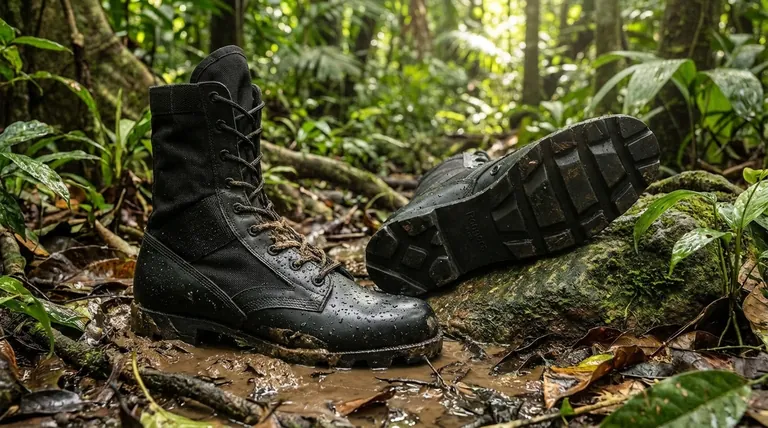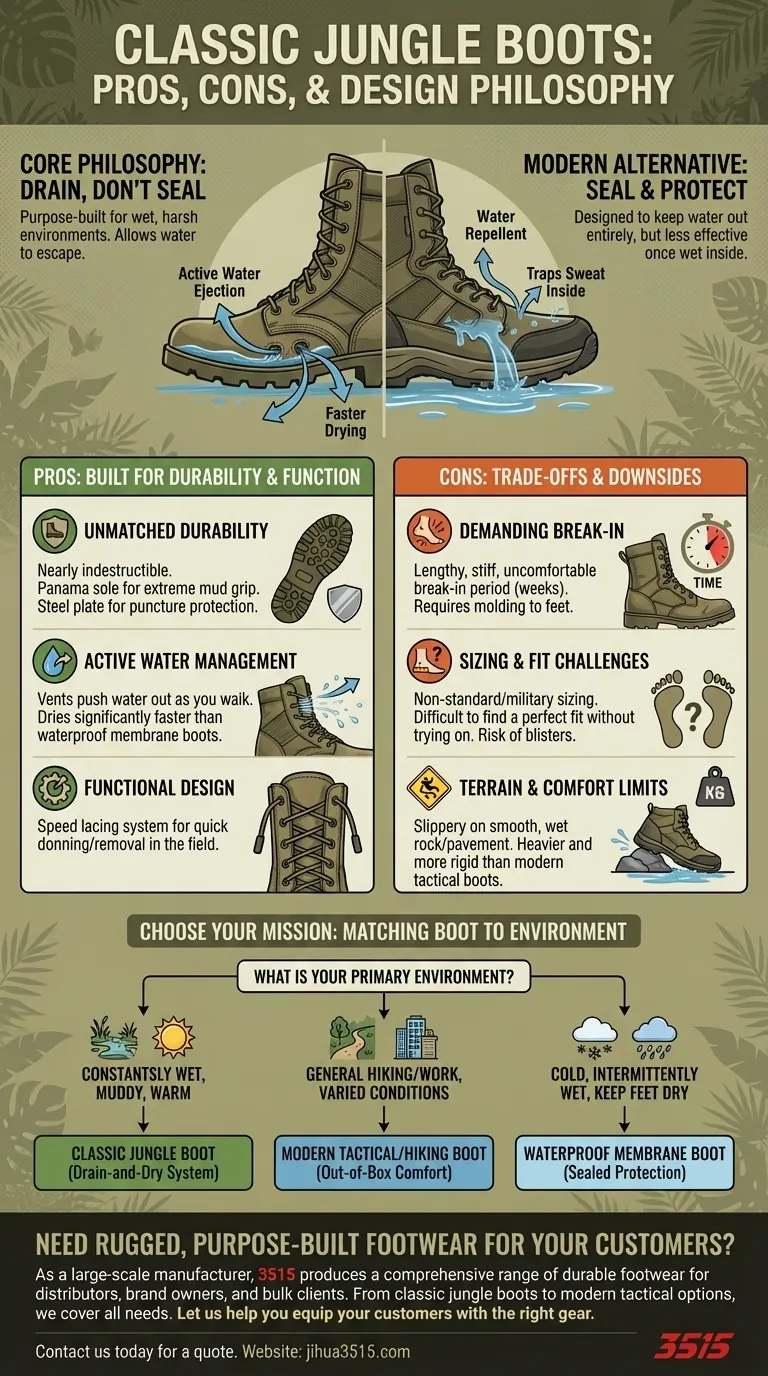At their core, classic jungle boots offer a trade-off between extreme durability and immediate comfort. They are purpose-built for wet, harsh environments, providing outstanding protection and drainage, but they demand a significant break-in period and are less versatile than modern alternatives.
The fundamental choice is not about which boot is "better," but which design philosophy matches your specific environment. Classic jungle boots are designed to get wet and dry quickly, while many modern boots are designed to keep water out entirely.

The Core Design Philosophy of the Jungle Boot
The original jungle boot is a specialized tool, and every feature serves a specific, harsh-environment purpose. Understanding this intent is key to appreciating its strengths.
Built for Unmatched Durability
Classic jungle boots are renowned for being nearly indestructible when properly cared for. Their construction prioritizes resilience over flexibility.
A key feature is the Panama sole, a thick lug pattern designed to shed mud and provide exceptional grip in soft terrain. Many also include a steel plate integrated into the sole for critical protection against punctures from sharp objects on the ground.
Designed to Drain, Not to Be Waterproof
This is the most misunderstood feature. Instead of a waterproof membrane, classic jungle boots have drainage holes or vents near the instep.
The philosophy is simple: in a jungle or swamp, your feet will get wet. A waterproof boot would trap that water inside. The jungle boot is designed to let water in and then actively push it out as you walk, allowing your feet and socks to dry much faster.
Engineered for Function
Features like the speed lacing system were designed for practicality, allowing soldiers to don or remove the boots quickly in the field. Every element is built around survival and performance in its intended environment.
Understanding the Trade-offs and Downsides
The specialized nature of the jungle boot introduces significant drawbacks when used outside of its intended context.
The Demanding Break-in Period
Unlike modern boots, classic jungle boots require a lengthy and often uncomfortable break-in period. The stiff materials must be molded to your feet through wear, which can take weeks.
Sizing and Fit Challenges
These boots often come in non-standard or military-specific sizing, making it difficult to find a perfect fit without trying them on. An improper fit can lead to severe discomfort and blisters, negating the boot's protective benefits.
Performance Varies with Terrain
While excellent in mud, the hard rubber of the Panama sole can be slippery on smooth, wet surfaces like rocks or pavement. Their performance can also feel different when you are carrying a heavy load, requiring you to test them thoroughly before relying on them.
A Stark Contrast to Modern Comfort
Compared to modern tactical boots, which often feel like athletic shoes, jungle boots are heavier and far more rigid. Modern boots prioritize out-of-the-box comfort and breathability, making them better suited for long hours of wear in more varied, less extreme conditions. However, this comfort often comes at the cost of the rugged durability found in a classic jungle boot.
How to Apply This to Your Goal
Choosing the right footwear depends entirely on your mission. Consider the most likely conditions you will face.
- If your primary focus is extreme durability in consistently wet, muddy, and warm environments: The classic jungle boot's drain-and-dry system is a proven and highly effective solution.
- If your primary focus is out-of-the-box comfort for general hiking or work: A modern tactical or hiking boot will provide a much better user experience with minimal break-in time.
- If your primary focus is keeping your feet dry in cold or intermittently wet conditions: A waterproof boot with a modern membrane is the superior choice over a boot designed for drainage.
Ultimately, choosing the right boot means matching its core design philosophy to the demands of your environment.
Summary Table:
| Feature | Pro | Con |
|---|---|---|
| Durability | Nearly indestructible; steel plate for puncture protection. | Very stiff, requires a long break-in period. |
| Water Management | Drains water quickly; ideal for constantly wet environments. | Not waterproof; designed to get wet. |
| Traction | Panama sole excels in mud and soft terrain. | Can be slippery on wet, smooth surfaces like rock or pavement. |
| Comfort & Fit | Extremely rugged construction. | Heavy, rigid, and often has non-standard sizing. |
Need Rugged, Purpose-Built Footwear for Your Customers?
As a large-scale manufacturer, 3515 produces a comprehensive range of durable footwear for distributors, brand owners, and bulk clients. Whether you need classic jungle boots for extreme conditions or modern tactical boots for everyday comfort, our production capabilities encompass all types of shoes and boots.
Let us help you equip your customers with the right gear for their mission.
Contact 3515 today to discuss your manufacturing needs and get a quote.
Visual Guide

Related Products
- Durable Military Combat Boots with Water Drainage for Wholesale & OEM
- Wholesale Waterproof Tactical Boots Custom Suede & High-Traction Soles
- Durable Leather Tactical Boots Wholesale & Custom Manufacturing for Brands
- Wholesale Lightweight Tactical Boots with Dial Closure OEM & Bulk Orders
- Durable Leather High-Ankle Tactical Boots for Wholesale & Custom Manufacturing
People Also Ask
- What are military boots designed for? Unmatched Durability & Protection for Extreme Conditions
- How do luxurious ostrich leather shoes differ from traditional dress shoes? A Guide to Texture & Comfort
- What are the key features of the new Army Jungle Combat Boot? A Breakdown for Hot & Wet Environments
- What are the limitations of combat boots? Understanding the Trade-offs of Rugged Footwear
- Why has Cordura remained relevant despite new fabrics? The Unbeatable Balance of Durability & Comfort



















